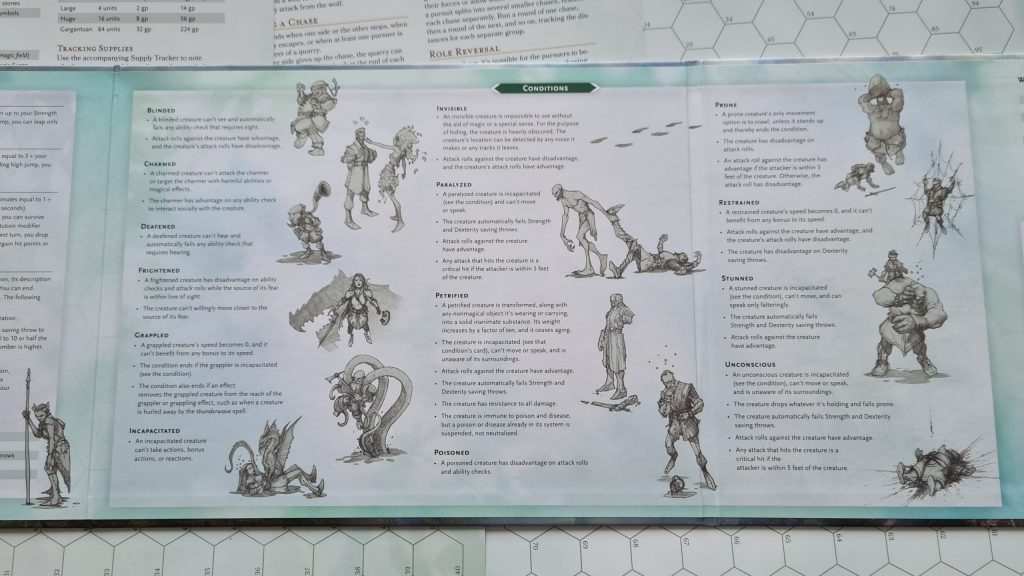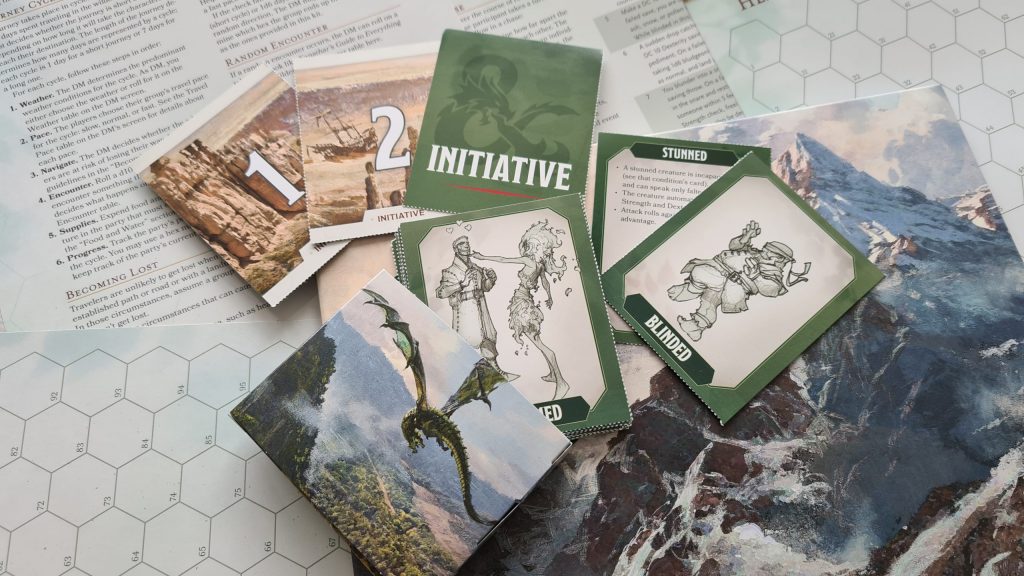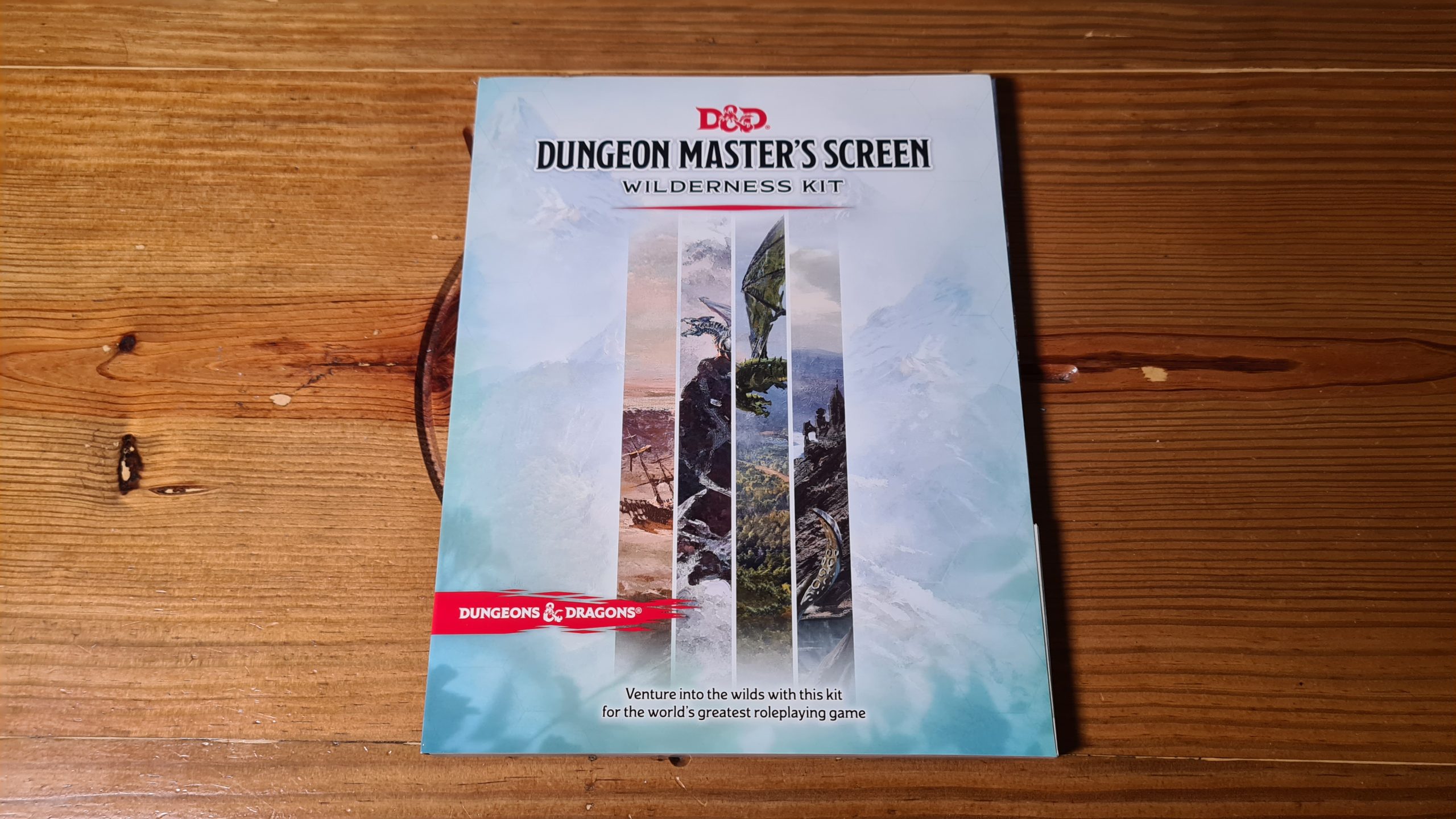Wizards of the Coast has just released the Dungeons & Dragons: Dungeon Master’s Screen Wilderness Kit. Designed for players about to venture out into the wild parts of the world, the set includes a variety of items to make playing easier. From a Dungeon Master screen to cards to hand out to players, each are tools to help the dungeon master or the adventurers. However, is getting the set a wild idea? Let’s find out!
Let’s start with the main part of this set, the Dungeon Master’s (DM’s) screen. On the adventure-facing side are glorious depictions of vistas with a twist, such as a mountain range with a swooping dragon or a canyon crater with a deserted pirate ship. The reverse is designed to make a DM’s life that bit easier. From associated abilities for skill checks to common conditions and their effects, it has plenty of information at a DM’s fingertips. This means they will be diving into the various rulebooks that bit less, keeping the experience flowing.
Compared to what is on it to the Essentials Kit DM screen, gone are the sizes of creatures and things you can do on a turn. Replacing them are things adventurers might encounter when not in standard rural locations. These range from weather effects, such as rain impacting visibility or strong winds, through to encounter distances on different terrains. While the realm of Icewind Dale might not spring to mind when talking about wilderness, even extreme cold is mentioned on the screen.

A panel and a half is used to detail conditions, from being incapacited to petrified. These aren’t specific to the wilderness but it would be useful not to have to look them up as a new DM. Compared to other available DM screens the Wilderness Kit is of good quality. It’s not got an overly gloss finish, which could have resulted in it being hard to read in certain light conditions. Also, it is thicker than the official Wizards of a Coast screen found in the Essentials Kit, but not quite as much as the screen from the recent Curse of Strahd Revamped set.
Three laminated hex grid sheets are included, which can be used to plot a course across a province or larger section of the world map, with one being a hex map on both sides. An interesting usage of these could be for the DM to draw on areas of interest on a secret hex grid and allow the adventurers to plot a route. Based on the route taken by players the DM can then trigger events or encounters based upon the player choices.
On the reverse of one sheet is a supplier tracker. Depending on the group, players can also keep track of their rations on this supply tracker. This can at times be a bit tedious to do, but with a wipeable sheet the list can easily be kept updated. On the back of the final hex map is an Actions in Combat list, which really is only going to be useful for those in their first couple of games. Laid out neatly are the likes of casting spells and dashing. It’s the basics which would be handy to have in front of you for an initial foray into the world of D&D, yet they swiftly become common knowledge. Two other sheets are included featuring ideas of journeys and chases that the players might bump into, so not everything instantly throws the adventurers into combat or survival skill checks.

The main focus of the set is for when adventuring parties are out and about in the wilderness. Still, a number of the included bits could always be useful. When playing with relatively new players the 18 condition cards can be invaluable. Rather than the player having to remember something or flick through the player handbook they can simply keep the card on top of their player sheets. Therefore, it serves as a reminder for both that the player is affected by something and what that effect is. The downside is that there are only 1 of each condition. Commonly, if one player has been poisoned by a monster another character might also be later in the combat – and there is only the one poison condition card.
Having initiative value cards to hand is also something that will help newer groups of players, and even some easily distracted experienced ones. Most will easily get that play doesn’t go around the table. Still, not having to rely solely on the DM to state who plays when in the turn order is a nicety for all involved. These cards, both condition and initiative, are more targeted towards newer players. Those with plenty of D&D 5e experience will have come across the conditions and seen enough combat that initiative is never an issue, though smoothing the process to getting to that level is always welcome. Coming flat pack, a helpful inclusion to store all of the cards is a card storage box. It might be a little thin but it isn’t overly flimsy and doesn’t even need glue or tape to stay together.
The Dungeons & Dragons: Dungeon Master’s Screen Wilderness Kit will either be exactly what you and your group is looking for, or parts of it will be almost irrelevant to you. The cards for conditions and initiative are a useful inclusion but will be used less and less as players’ experience grows. Still, for the DM to no longer have to constantly remind players things with those new to D&D they should make the experience smoother. There is the question of how much players will be out in the wilderness. Even when out exploring a forest or swamp adventurers may come across settlements. The DM screen only then works for the time out in the wild, so it is best as an addition to a standard DM screen, which includes the likes of random encounters. Overall, this could be the set for you but won’t be used consistently by most.
(Editor’s Note: The Dungeons & Dragons: Dungeon Master’s Screen Wilderness Kit was provided to us by Asmodee for the review. The product is currently available from local board game stores! Find your local store here.)

